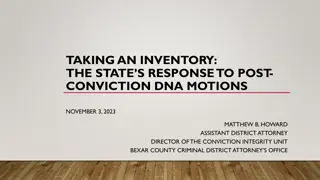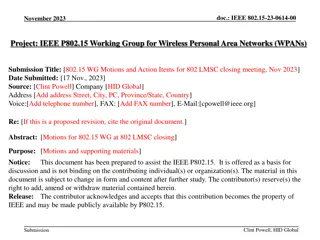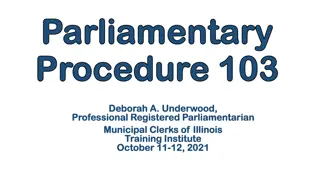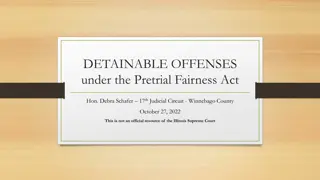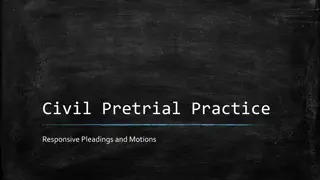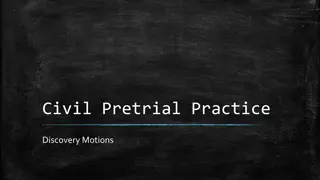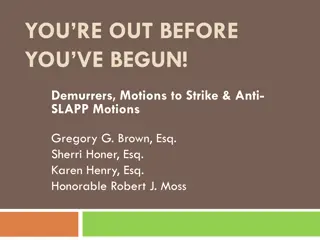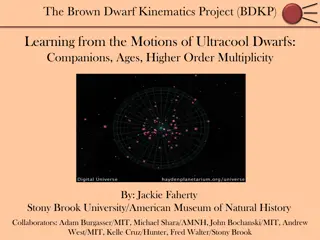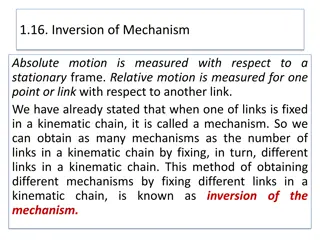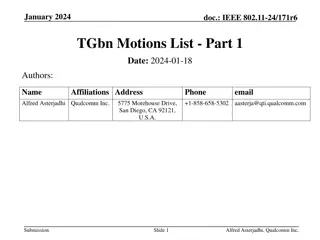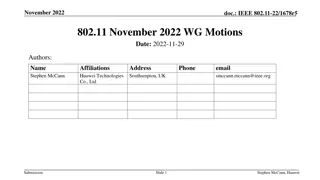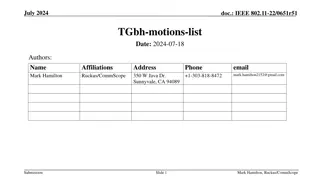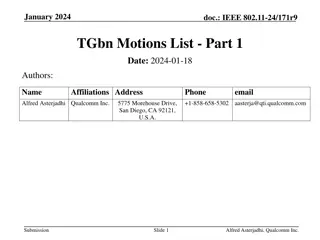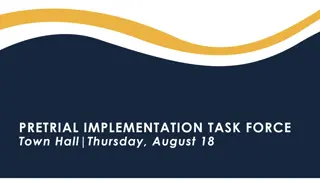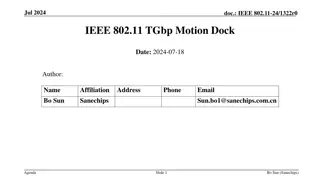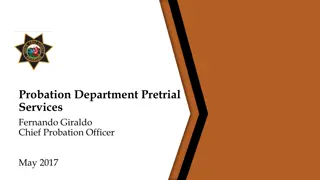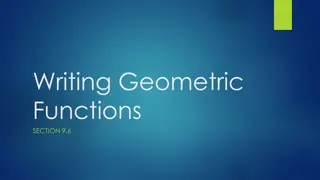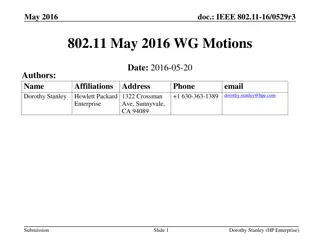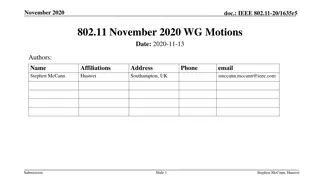Understanding Pretrial Motions in Limine in Civil Pretrial Practice
Pretrial motions in limine (MIL) play a crucial role in civil pretrial practice by seeking evidentiary rulings in advance to control the introduction of evidence at trial. These motions aim to prevent the admission of irrelevant, inadmissible, or prejudicial evidence and can also facilitate the introduction of relevant evidence. By leveraging the court's inherent powers, attorneys can strategically utilize MIL to streamline trial proceedings, avoid juror exposure to harmful evidence, and enhance the overall trial strategy.
Download Presentation

Please find below an Image/Link to download the presentation.
The content on the website is provided AS IS for your information and personal use only. It may not be sold, licensed, or shared on other websites without obtaining consent from the author. Download presentation by click this link. If you encounter any issues during the download, it is possible that the publisher has removed the file from their server.
E N D
Presentation Transcript
Civil Pretrial Practice Pretrial Motions in Limine
Pretrial Motions in Limine (MIL) Motions in limine are used toobtainanevidentiary ruling in advance. Most commonly, this is to prevent the introduction of matters at trial which are irrelevant, inadmissible or prejudicial but may also be used to permit the introduction ofevidence. The primary advantage of the motion in limine is to avoid the futile attempt of trying to undo the harm done where jurors have been exposed to damagingevidence, even where stricken bythe court. This scenario has been described as the obviously futile attempt to unring the bell in the event a motion to strike is granted in the proceedings before the jury. Hyattv.Sierra Boat Co.(1978) 79 Cal.App.3d 325, 337.
Pretrial Motions in Limine (MIL) Authority & Legal Standard Motions in limine are not expressly authorized by statute.Instead, authority for motions in limine may be implied from the court s inherent powers. K.C. Multimedia, Inc. v. Bank of America Technology & Operations, Inc. (2009) 171 Cal.App.4th 939. These inherent powers include the power to: Provide for the orderly conduct of proceedings before it, or its officers. CodeCiv. Proc., 128 (a)(3)); and Control its process and orders so as to make them conform to law and justice.CodeCiv. Proc., 128 (a)(8).
Pretrial Motions in Limine (MIL) Timing & Procedural Requirements Motions in limine are not noticed motions. CRC, rule 3.1112(f) provides that: a motion in limine filed before or during trial need not be accompanied by a notice of hearing. CRC, rule 3.20(a), which preempts all local rules relating to pleadings, motions, and the form and format of papers, does not apply to motions in limine since they arerecognizedaspartofthetrial proceedings.SeeCRC,rule 3.20(b)(1). There is no uniform practice for counsel to follow regarding when motions in limine shouldbe filedandserved andwhenthey areheardby the court. The timing and place of the filing and service of the motion in limine are at the discretionofthetrialjudge.CRC,rule 3.1112(f). Practice Tip: Considering that motions in limine are regulated by the court s inherent powers, including the power to control the proceedings, you must determine the trial judge s preferences regarding the timing and form of motions inlimine.
Pretrial Motions in Limine (MIL) Timing & Timing & Procedural Requirements - Examples In the Los Angeles Superior Court, if you have a personal injury ( PI ) case and are assigned to one of the PI courts, then before filing motions in limine, the parties/counsel shall comply with the statutory notice provisions of CCP section 1005 and the requirements ofLASCR, rule3.57(a). In the San Francisco Superior Court, motions in limine must be served by mail at least ten (10) days before the date set for trial or personally served at least five (5) days before the date set for trial. Oppositions must be personally filed and served no later than the date set for trial. (See, Superior Court of San Francisco County, LocalRules, rule6.1.)
Pretrial Motions in Limine (MIL) Meet & Confer Requirement Many jurisdictions require counsel to meet and confer regarding motions in limine i.e., LASCR, rule 3.57(a)(2); Superior Court of FresnoCounty,Localrules, rule2.6.1. Through the meet-and-confer process, counsel may determine it is more worthwhile to stipulate to issues involving typical trial matters rather than waste the court s time with an unnecessary motion in limine. The meet-and-confer process is essential to narrow down the list of motions in limine a party may have to file and that a judge needs to hear.
Pretrial Motions in Limine (MIL) Stipulations Many standard issues, i.e., day-to-day trial logistics and common professional courtesy, should be addressed and disposed of in a stipulation between counsel rather than in motions in limine. Kelly v. New West Federal Savings (1996)49Cal.App.4th 659,670-672. These standardissues include, butare notlimited to: Document authenticity; Exclusion of witnesses before testimony; Financial information; Mention of insurance coverage; Use of demonstrative evidence; Admission of uncontested reports.
Pretrial Motions in Limine (MIL) Form of Motions in Limine Most courts require written motions in limine. See e.g., LASCR, rule 3.57; SFSCR, rule 6.1. However, counsel is not necessarily precluded from making an oral motion in limine during trial. Kelly v. New West FederalSavings, supra, 49Cal.App.4th at669. The motion in limine and any opposing papers should be filed separately with their own points and authorities, supporting declarations andother evidence. The caption of each motion in limine should specifically and clearly identify the numberofthe motion andthe substance ofthe motion. Some courts require consecutive numbering so again, it s imperative to find out what your trial judge prefers.
Pretrial Motions in Limine (MIL) Substance of Motions in Limine The papers filed in supportof a Motion in Limine must consist of at least the following: The motion itself with a brief description of the evidence sought to be excluded or admitted and the basis of the motion and the relief sought. A memorandum in support of the motion with a detailed factual and legal analysis to support why the evidence should be excluded or admitted. Adeclaration that includes the following: (1)Specific identification of the matter alleged to be inadmissible and prejudicial; (2) A representation to the court that the subject of the motion has been discussed with opposing counsel, and that opposing counsel has either indicated that such matter will be mentioned or displayed in the presence of the jury before it is admitted in evidence or that counsel has refused to stipulate that such matter will not be mentioned or displayed in the presence of the juryunless and until it is admitted in evidence; (3) A statement of the specific prejudice that will be suffered by the moving party if the motion is not granted; and (4) If the motion seeks to make binding an answer given in response to discovery, the declaration must set forth the question and the answer and state why the use of the answer for impeachment will not adequately protect the moving party against prejudice in the event that evidence inconsistent with the answer is offered. ProposedOrder. Other papers may be filed in support of the motion, including additional declarations, exhibits, appendices, and other documents orpleadings.CRC, rule 3.1112(b).
Pretrial Motions in Limine (MIL) Improper Uses of Motions in Limine Do not file a motion in limine to exclude evidence which is clearly inadmissible. Do not waste your time or the court s time trying to have a motion in limine heard on anobviousmatteror one that is not supportedbythe factsandlawof yourcase. Beware of filing motions in limine which are really disguised motions for summary judgment. A motion in limine to, in effect, assert a late-filed motion for summary judgment or summary adjudication is improper. LASCR, rule 3.57(b). Beware of filing motions in limine which are really disguised motions to bifurcate. A motion in limine may not be used for the purpose of seeking an order to try an issue before the trial of anotherissue or issues. LASCR, rule 3.57(c). Beware of filing motions in limine which are really disguised motions to compel brought after the discovery cut-off and motion cut-off dates have passed. Counsel should not address violations of the discovery rules in motions in limine which should have been timely dealt with in amotion tocompel. LASCR, rule 3.57(a)(4).
Pretrial Motions in Limine (MIL) Compliance with the Court s Ruling Make sure the motion, the court s ruling and the reasons for the ruling are all made on the record to preserve the objection for appeal. If the judge makes a pretrial ruling, then all counsel are bound by that ruling during the trial. If the judge excludes the evidence, then it may not be mentionedin trial or argument. If the motion in limine is granted, then all counsel have the duty to inform their associates, witnesses, clients and any other persons under counsels control that no mention or display of the excluded evidence shouldbe madeinthe presenceof the jury. LASCR, rule 3.57(e). Practice Tip: If the judge decides not to make a pretrial ruling on the motioninlimine,counsel should: (1) Ask the court to clarify that the evidence may not be referred to until the judge makes aruling; and (2) At the time a party wants to introduce the evidence which is the subject of a motion in limine, the party should ask for a ruling on the deferred motion.
Pretrial Motions in Limine (MIL) Cal. Evidence General Rules of Admissibility In general, if evidence is shown to be relevant, material, and competent, and is not barred by an exclusionary rule, it is admissible. Cal. Evid. Code 351. Evidence is relevant when it has any tendency in reason to make the fact that it is offered to prove or disprove either more or less probable. Cal. Evid.Code 210. Evidence is material if it is offered to prove a fact that is at issue in the case. Evidence is competent if the proof that is being offered meets certain traditional requirements of reliability. The preliminary showing that the evidence meets those tests, and any other prerequisites of admissibility, is called the foundational evidence.Cal. Evid.Code 402, 403. Establishing these basic prerequisites, and any other special ones that may apply,is called laying a foundation.
Pretrial Motions in Limine (MIL) Cal. Evidence Four Types of Evidence 1. Real evidence is a thing the existence or characteristics of which are relevant and material. It is usually a thing that was directly involved in some event in the case (Example: written contract to establish existence of an agreement in a contract case, weapon in assaultor batterycase); Real evidence may be authenticated in three ways: (1) by identification of a unique object, (2) by identification of an object that has beenmadeunique,and(3)byestablishingachain of custody. The proponent of the evidence must also establish that the object, in relevant respects, has not changed or been altered between theeventsandthetrial. 2. Demonstrative evidence demonstrates or illustrates the testimony of a witness. (Example: Maps, diagrams of the scene of an occurrence, animations); Demonstrativeevidenceisauthenticatedbythewitnesswhose testimony isbeingillustrated. 3. Documentaryevidenceisoften atypeof real evidence, (Example: writtencontracttoprove the termsof theagreement); Documents present special problems not presented by other forms of real evidence, such as hearsay, authentication and best evidence rules. 4. Testimonialevidenceconsistsof what issaidinthe courtattheproceedinginquestionbya competentwitness. In general, a witness is competent if he meets four requirements: (1) takes and understands the oath or a substitute. Cal. Evid. Code 710, 701; (2) have personal knowledge about the subject of his testimony. Evid. Code 702; (3)Remember what he perceived; and(4) Beableto communicatewhat they perceived.Cal.Evid.Code 701(a)(1). Testimonial evidence doesnot usually require another form of evidence as a prerequisite for its admissibility. SeeCal. Evid. Code 702(b).
Pretrial Motions in Limine (MIL) Cal. Evidence Opinion Testimony The court may, and upon objection shall, exclude testimony in the form of an opinion that is based in whole or in significant part on matter that is not a proper basis for such anopinion. Cal. Evid.Code 803. Lay Opinions: In general, a person who is not testifying as an expert will be allowed to testify in the form of an opinion if the opinion is both rationally based on his perception and helpful to an understanding of his testimony. Cal. Evid. Code 800. This includes statements of what they saw,heard, felt, tasted,or smelled. They are generally forbidden toexpress opinions or draw conclusions. Expert Opinions: An expert providing testimony in the form of an opinion is limited to such an opinion as is: (b) Based on matter (including his special knowledge, skill, experience, training, and education) . . . unless an expert is precluded by law from using such matter as a basis for his opinion. Cal. Evid. Code 801.
Pretrial Motions in Limine (MIL) Cal. Evidence Character Evidence The general rule that evidence of character is not admissible to show action in conformity with it.Cal. Evid.Code 1101. Character evidence may be proved where it is directly in an issue or is put in issue in a particular case. Cal. Evid. Code 1101(b). A witness's character for veracityis alwaysputin issue when he takes the stand Example: A Plaintiff's character and reputation may be in issue in an action for slander or libel where the defendant attempts to show that the plaintiff's reputation was already so bad that he could not have suffered any harm from the disparaging statement. While character cannot be proved to show action on a particular occasion in conformity with it,habit can.Cal.Evid.Code 1105. Character is a generalized quality usually attributed to a person, such as truthfulness, violence, drunkenness, andthe like. A habit is a specific, regular, and consistently repeated behavior, such as a practice of alwayslocking one's doors.
Pretrial Motions in Limine (MIL) CA Evidence Common Evidentiary Grounds 1. No evidence is admissible except relevant evidence.Cal.Evid.Code 350. 2. The court in its discretion may exclude evidence if its probative value is substantially outweighed by the probability that its admission will (a) necessitate undue consumption of time or (b) create substantial danger of undue prejudice, or confusing the issues, or of misleading the jury. Cal. Evid.Code 352. 3. Evidence of subsequent remedial measures is not admissible to show previous negligence or culpable conduct.Cal. Evid.Code 1151. 4. Evidence of mediation or settlement discussions is not admissible to prove liability for the claims that were being discussed. Cal. Evid. Code 1152, 1152.5. 5. Evidence of liability insurance is inadmissible to prove negligence or other wrongdoing.Cal. Evid.Code 1155.
Pretrial Motions in Limine (MIL) Conclusion Well-conceived and thoughtful motions in limine will be effective to define and narrow the issues at trial. Be sure to take the time to carefully craft motionsin limine sothey are custom-tailored tothe case athand. Using your firm s boilerplate motions in limine will be inefficient and a waste of the court s time. Certain issues can be stipulated to during the meet-and-confer process. An ill-conceived or vague motion in limine will consume the court s valuable time and may not be granted. Filing motions in limine which involve inconsequential or obviousissues is counterproductive. Remember that trial judges want to resolve pretrial issues efficiently and quickly, so stipulate with opposing counsel to standard issues and file motionsin limine that matter. Refresh yourselves on the rules ofevidence!


